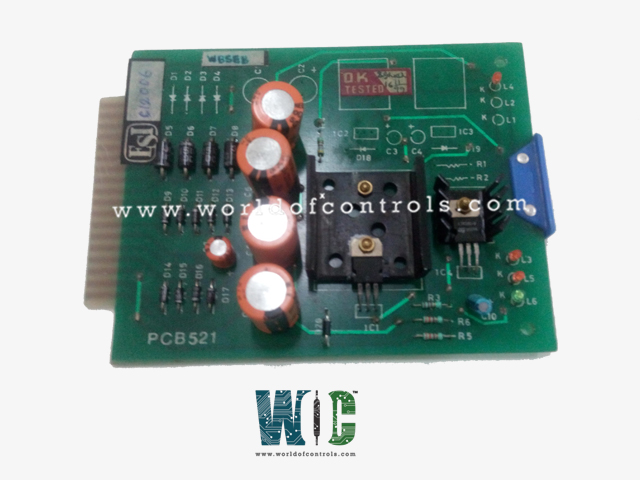
World Of Controls understands the criticality of your requirement and works towards reducing the lead time as much as possible.
PCB 521 - PCB Transmitter Module is available in stock which ships the same day.
PCB 521 - PCB Transmitter Module comes in UNUSED as well as REBUILT condition.
To avail our best deals for PCB 521 - PCB Transmitter Module, contact us and we will get back to you within 24 hours.
SPECIFICATIONS:
Part Number: PCB 521
Manufacturer: GE
Series: Mark II
Product Type: PCB Transmitter Module
Bridge Power Supply: 10 VDC �0.3VDC
Power Supply: 5V
Sensitivity Adjustable Range: 2000 times 1/1 ~1/4 times adjustable
Output: �10 V
Power supply: 24 VDC 100 mA
Output Load Resistance: 2 k-ohm
Input range: 10 V output at theinput of 0.5 mV/V
Weight Approx: 100 g
Product Origin: USA
FUNCTIONAL DESCRIPTION:
PCB 521 is a PCB Transmitter Module manufactured and designed by General Electric. It is part of the Mark I & II Series used in gas turbine control systems. The wireless or signal-based transmission of critical control data, sensor feedback, or status signals within the turbine�s control architecture. These modules are crucial in ensuring precise, real-time communication between various control units, sensors, and actuators in gas, steam, or hydro turbines. They are typically used in conjunction with other PCB-mounted devices like signal conditioners, input/output cards, and controllers to support safe, efficient, and automated turbine operation.
OPERATION:
The PCB Transmitter Module in a turbine control system functions by taking sensor inputs or control commands, such as temperature, pressure, vibration, or speed data, and converting them into standardized electrical signals or wireless transmissions, depending on the design. These signals are then sent to the turbine control unit or Distributed Control System (DCS). For example, in systems with analog or 4-20 mA current loops, the transmitter module ensures accurate signal transmission over long distances with minimal interference. Some modern turbine systems use digital communication protocols (such as Modbus or CAN) transmitted via PCB modules that are built to endure high EMI environments typical in power plants. The modules are engineered for high reliability and safety, often featuring isolation, surge protection, and redundancy.
WOC maintains the largest inventory of Replacement Parts for GE Speedtronic Turbine Control Systems. Additionally, we offer warranty-backed unused and rebuilt boards as well as board repairs for damaged ones. For your OEM needs, our team of professionals is available around the clock. We at WOC are happy to help you with any automation needs you may have. Please contact our team by phone or email for pricing and availability on any components and repairs.
How do PCB transmitter modules achieve galvanic isolation, and what are typical isolation ratings?
Galvanic isolation is achieved using high-speed digital opto-isolators, pulse transformers, or capacitive isolators (e.g., Analog Devices iCoupler or Texas Instruments ISO series). Typical isolation ratings are 2.5 kV to 5 kV RMS to protect low-voltage control circuitry from high-voltage field signals or transients.
What is the typical input impedance for analog inputs in these modules?
Analog input channels are typically designed with input impedances of <1 M Ohm for voltage inputs and <250 Ohm for current (4�20 mA) inputs to maintain compatibility with industrial transmitters and to minimize loading errors.
What diagnostic and self-test functions are integrated?
These include input open/short detection, loop integrity testing, internal voltage reference monitoring, EEPROM CRC checks, and status flag outputs. Some systems interface with Asset Management Systems (AMS) or Field Device Tool (FDT/DTM) frameworks for advanced diagnostics and remote calibration.